InterviewSolution
Saved Bookmarks
This section includes InterviewSolutions, each offering curated multiple-choice questions to sharpen your knowledge and support exam preparation. Choose a topic below to get started.
| 1701. |
If 2x-1 is a factor of 4x^(3) - 16x^(2) + 10x + k, find the value of k. |
|
Answer» |
|
| 1702. |
Gopal bought two types of shares P and Q, of a company at their face values. The dividend rates provided by P and Q are 9% and 12%, respectively. Gopal received an annual dividend of Rs.4500 more from P than from Q. Which of the following can be the ratio of his investments in P and Q? |
|
Answer» `6:5` (ii) If the ratio of investments on P and Q is `4:3`, dividend is same on both P and Q. (iii) Therefore, required INVESTMENT MUST be more than `4:3` for the given condition. (iv) Check the options to GET the ratio which is more than `4:3`. |
|
| 1703. |
The perimeter of rhombus ABCD is 40 cm and BD = 16 cm. Then, ar (ABCD) = ……………cm^(2). |
|
Answer» 96 |
|
| 1704. |
Construct a triangle PQR, such that angleP=50^(@), angleQ=30^(@) and PQ-QR = 1.4 cm. |
|
Answer» Solution :Step 1: Draw `bar(PX)`. Step 2: Locate the point `S` on `bar(PX)`, such that `PS=1/4 cm.` Step 3: Draw `bar(SY)`, such that `anglePSY = 180^(@)-1/2` `(180^(@)-ANGLEQ)=180^(@)-1/2(180^(@)-30^(@))=105^(@)`. Step 4: Draw `bar(PZ)`, such that `angleSPZ=50^(@)`, intersecting `bar(SY)` at `R.` Step 5: Draw perpendicular bisector of `bar(RS)` intersecting `bar(PX)` at `Q.` Step 6: Join `Q` and `R.` `PQR` is the required TRIANGLE. 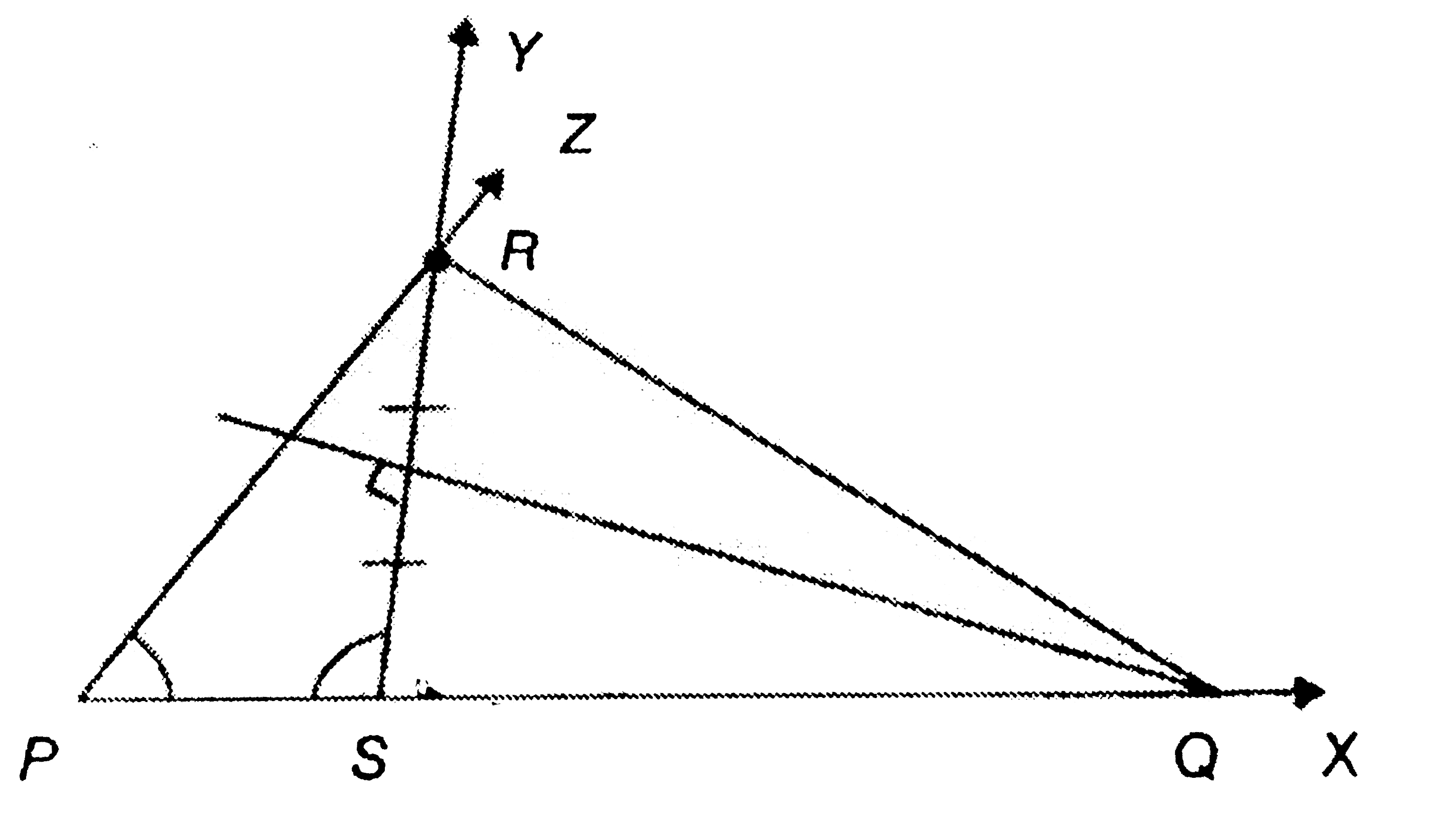
|
|
| 1705. |
Find the area of a figure formed by joining the mid-points of the adjacent sides of a rhombus with diagonals 12 cm. and 16 cm. |
|
Answer» |
|
| 1707. |
The measurements of the sides of a triangle are 20 cm, 30 cm and 40 cm. Find the area of this triangle. |
|
Answer» |
|
| 1708. |
Classify the following polynomials into linear quadratic and cubic polynomials : 4x - 9x^(2) + 3 |
|
Answer» |
|
| 1709. |
Examine, whether the following numbers are rational or irrational : (10)/(10sqrt5) |
|
Answer» |
|
| 1710. |
A sum of money, invested at compound interest, amounts to Rs 16,500 in 1 year and to Rs 19,965 in 3 years. Find the rate per cent and the original sum of money invested. |
|
Answer» |
|
| 1711. |
What can you say about the position of the points (5,4) (8,4) (3,4), (0,4), (-4,4), (-2,4)? Locate the points on a graph sheet. Justify your answer. |
|
Answer» |
|
| 1712. |
A company manufactures car batteries of particular type. The life (in years) of 40 batteries was recorded as follows: Construct a grouped frequency distribution table with exclusive classes for this data, using class intervals of size 0.5 starting from the interval 2-2.5. |
|
Answer» |
|
| 1713. |
Line segment AB is parallel to another line segment CD. O is the midpoint of AD (see the given figure). Show that (i) triangle = triangle DOC (ii)O is also the midpointof BC |
|
Answer» |
|
| 1715. |
Construct a quadrilateral ABCD in which AB =4.6 cm , BC=2.6 cm, CD=3.5 cm, AD=2.6 cm , and the diagonal AC=4.9 cm. |
|
Answer» SOLUTION :Step 1: DRAW a line SEGMENT AB=4.6 cm. Step 2: With A and B as the centers,draw TWO arcs of radii 4.9 cm and 2.6 cm respectively to intersect each other at C. Step 3: With C and A as the centers, draw two arcs of radii 3.5 cm and 2.6 cm respectively to intersect at D. Step 4: Join BC, CD and AD to form QUADRILATERAL ABCD. ABCD is the required quadrilateral. 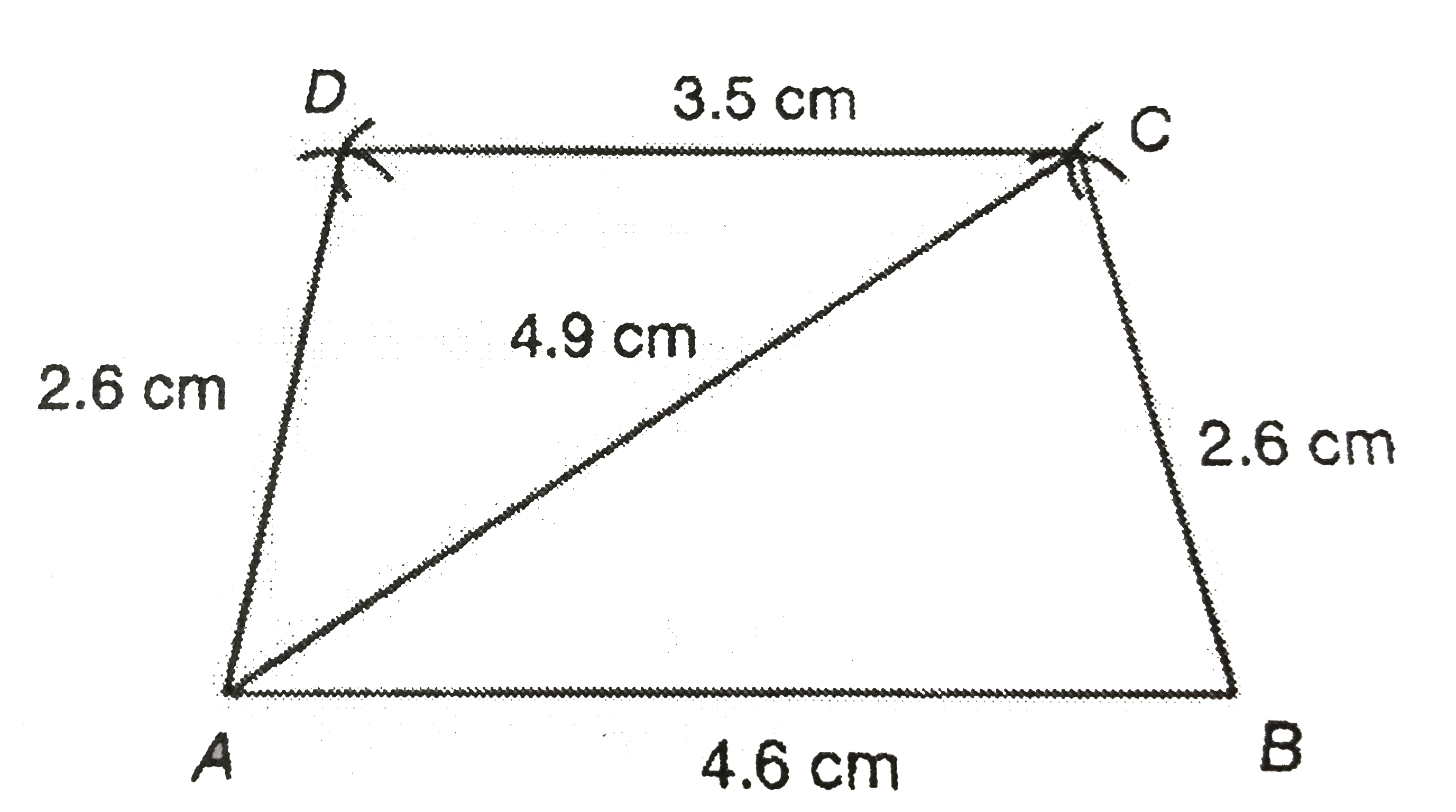
|
|
| 1717. |
Find the area of four walls of a room (Assume that there are no doors or windows ) if its length 12m. Breadth 10 m. and height 7.5 m. |
|
Answer» |
|
| 1718. |
A spinner was spun 1000 times and the frequency of outcomes was recorded as in given table: Find (a) List the possible outcomes that you can see in the spinner(b) Compute the probability of each outcome. (c) Find the ratio of each outcome to the total number of times that the spinner spun (use the table) |
|
Answer» |
|
| 1720. |
Solve for theta(0^(@) lt theta lt 90^(@)) : sin^(2)theta-1/2sintheta=0 |
|
Answer» |
|
| 1721. |
Construct and angle of 15^(@) using ruler and compasses only. |
|
Answer» Solution :STEPS OF CONSTRUCTION (i) Construct `angleAOB=60^(@)`, as indicated in EXAMPLE 3. (ii) Draw the bisector `OC` of `angleAOB`, as indicated in Example 2. (III) Draw the bisector `OD` of `angleAOC`, as indicated in Example 2. then, `angleAOD=15^(@)` is the require ANGLE. 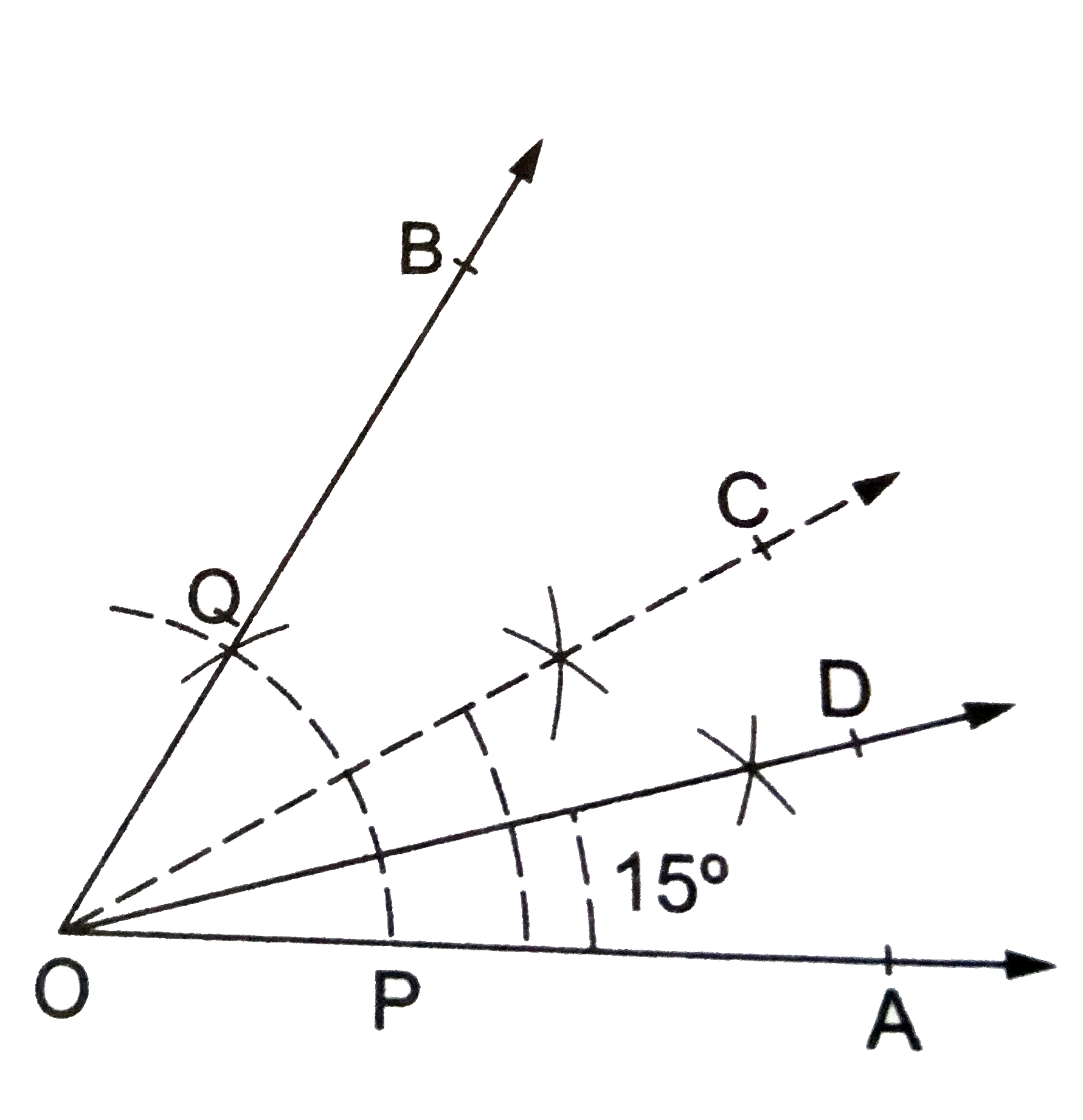
|
|
| 1722. |
pi is the proportion of the cirumference (let c) ofa circleto the diamter (let d) of it,i.e,pi = c/dwhere c and d are both terminting , then how ispi an irrational number ? Explain. |
|
Answer» |
|
| 1723. |
For each of the following polynomials, find p(0), p(1) and p(3) : p(x) = x^(2) - 4x +3 |
|
Answer» <P> |
|
| 1724. |
State whether the statements are True or False. Every parallelogram is a trapezium |
|
Answer» |
|
| 1725. |
A corn cob (see the given figure), shaped somewhat like a cone, has the radius of its broadest end as 2.1 cm and length (height) as 20 cm. If each 1 cm^(2) of the surface of the cob carries an average of four grains, find how many grains you would find on the entire cob. |
|
Answer» |
|
| 1726. |
Express the following rational numbers in decimal form. -(25)/(36) |
|
Answer» |
|
| 1727. |
If two lines intersect at P at right angle and pass through A(1,1) and B(1,0) respectively then what is the locus of P? |
|
Answer» |
|
| 1728. |
Express each of the following decimals in (p)/(q) form where qne0 and p, q are integers 15.4 |
|
Answer» |
|
| 1729. |
If 'a' and 'b' are rational numbers, find the value of a and b in each of the following equations. (sqrt5+sqrt3)/(2sqrt5-3sqrt3)=a-bsqrt(15) |
|
Answer» |
|
| 1730. |
Find the relative frequency of the last class-interval of question no.(iii) above. |
|
Answer» |
|
| 1731. |
An equilateral triangle, if its altitude is 3.2cm |
|
Answer» Solution :We know that , in an equilateral triangle all SIDES are equal and all angles are equal i.e.,each angle is of `60^(@)` . Given , altitudeof an equilateral triangle say ABC is `3.2cm` . To construct the `DeltaABC` use the following steps. (i) Draw a line PQ. (ii) Take a point D on PQ and draw a ray `DE bot PQ`. (iii) Cut the line segment AD of length `3.2cm` from DE. (iv) Make angles equal to `30^(@)` at A on both sides of AD say `angleCAD and angleBAD` , where B and C LIE on PQ. (v) Cut the line segment DC from PQ such that DC = AD (vi) Join AC Thus , `DeltaABC` is the required triangle. Justification Here, `angleA = angleBAD + angleCAD` = `30^(@) + 30^(@) = 60^(@)` Also, `AD bot BC` `:. angle ADB = 90^(@)` In `DeltaABDangleBAD + angleDBA = 180^(@)` [angle sum property] `30^(@) + 90^(@) + angleDBA = 180^(@)` [`angleBAD= 30^(@)`,by construction] `angleDBA = 60^(@)` Similary,`angleDCA = 60^(@)` Thus , `angleA = angleB = angleC = 60^(@)` Hence, `DeltaABC` is an equilateral triangle. 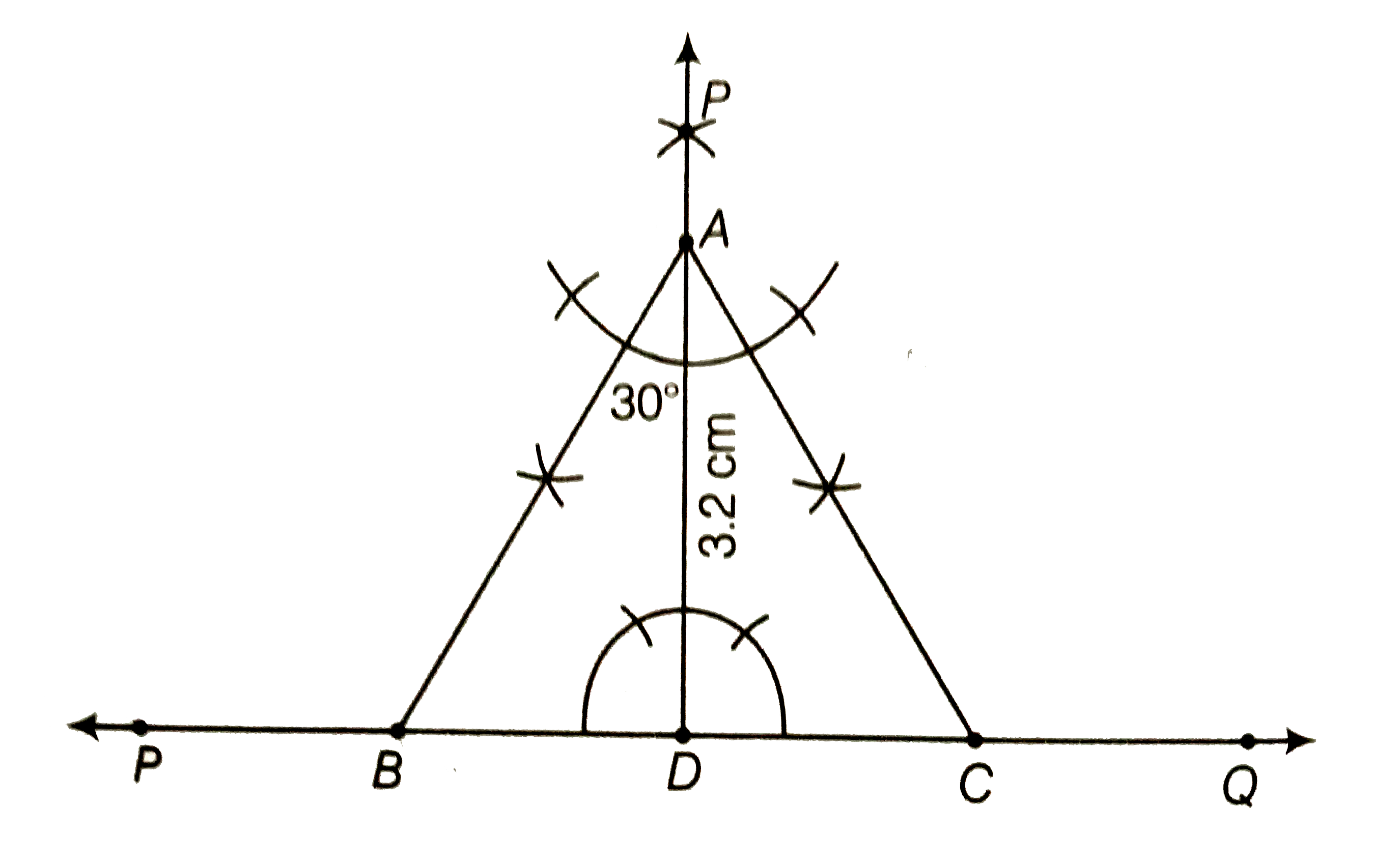
|
|
| 1732. |
In the given figure angle PQR=100^(@), where P,Q and R are points on a circle with centre 'O' Find angleOPR. |
|
Answer» |
|
| 1733. |
Following table shows a frequency distribution for the speed of cars passing through at a particular spot on a high way. Draw a histogram and frequency polygon representing the data above. |
|
Answer» Solution :Clearly, the given frequency distribution is in exclusive form. Along the horizontal axis, we present the class intervals on some suitable SCALE. The corresponding frequencies are represented along the vertical axis on a suitable scale. We construct rectangleswith class intervals as the bases and the respective frequencies as the HEIGHTS. ltbgt Let us draw a histrogram for this data and mark the mid-points of the top of the reactangles as B,C,D,E,F,G and H, RESPECTIVELY. Here, the first class is 30-40 and the last class is as B,C,D,E,F,G and H, respectively. Here, the first class is 30-40 and the last class is 90-100. Also, consider the imagined classes 20-30 and 100-110 each with frequency 0. The class MARKS of these classes are 25 and 105 at the points A and l, respectively. 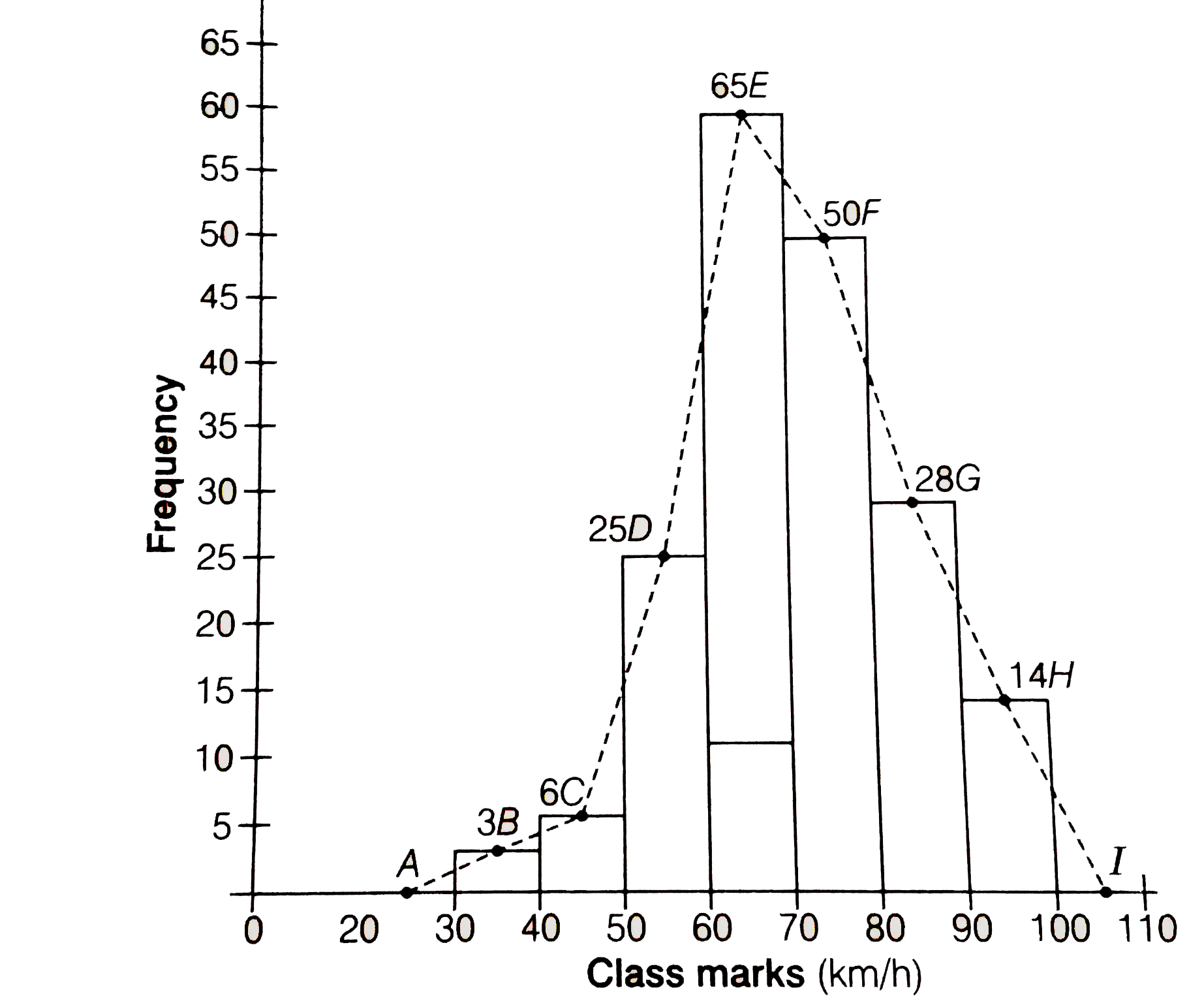 Join all these points by dotted line. Then, the curve ABCDEFGHI is the required frequency POLYGON. |
|
| 1734. |
Write an algorthim to arrange a given set of five number in desencding order |
| Answer» | |
| 1735. |
Factorise the following using appropriate identities. (i) 16x ^(2) + 24xy + 9y ^(2) (ii) 4y ^(2) - 4y +1 (iii) 4x ^(2) - (y ^(2))/( 25) (iv) 18a ^(2) - 50 (v)x ^(2) + 5x + 6 (vi) 3p ^(2) - 24 p + 36 |
|
Answer» <P> (ii) `(2y -1) ^(2)` (iii) `(2x + (y)/(5)) (2x - (y)/(5))` (IV) ` 2 (3a +5) (3a -5)` (v) `(x+3) (x+2)` (VII) `3(P -6) (P-2)` |
|
| 1736. |
The mean of 15 observations is 32. Find the resulting mean, if each observation is decreased by 7 |
|
Answer» |
|
| 1737. |
Write the coefficients of x^(2) in each of the following : 2-x^(2) + x^(3) |
|
Answer» |
|
| 1738. |
In x denotes thepercentageincrease in thenumberof firstgenerationinnigrants from1990 -2000 and ydenotesthe percantege increase in thetotalpopulationof US from1990-2000 which of thefollowingis equalto (x-y) ? |
|
Answer» 0.125 (ii) Firstfindpopulationof thefirstgeneration immigrants in 1990 and 2000 , i.e., 3%of 8k and 3.2%of 9k. (iii) When findpercentageincrease (X) (iv) `y=(1k)/(8k) (100)` and THENFIND (x-y) |
|
| 1739. |
Find the values of x and y in the figures given below |
|
Answer» (III) `x^@ = 90^@ ; y^@= 40^@` |
|
| 1740. |
ABCD is a cyclic quadrilateral. If AD||BC and angle B = 70^(@), find the other angles of ABCD. |
|
Answer» |
|
| 1741. |
The median of 14, 6, 2, 13, 9, 15 and 12 is ........ |
|
Answer» 21 |
|
| 1742. |
Write each of the following as an equation in two variables : 5y = 2 |
|
Answer» |
|
| 1743. |
Show that the median of a triangle divides it into two triangles of equal areas. |
|
Answer» |
|
| 1744. |
A lead pencil consists of a cylinder of wood with a solid cylinder of graphite filled in the interior. The diameter of the pencil is 7 mm and the diameter of the graphite is 1 mm. If the length of the pencil is 14 cm, find the volume of the wood and that of the graphite. |
|
Answer» |
|
| 1746. |
Find out which one of the followingnumbers is a rational and whichone is an irrational numbers : |
|
Answer» |
|
| 1747. |
State True or False, if 'false' write correct statement. The point (-x,-y) lies in the first quadrant where x lt 0, y lt 0. |
|
Answer» |
|
| 1748. |
True or False:Sector is the region between the chord and its corresponding arc. |
|
Answer» |
|
| 1749. |
In the following l II m and t is their transversal. If angleAXY=65^(@), find angleBYF,angleXYD,angleEXC and angleYXC. |
|
Answer» |
|
| 1750. |
Akhil invested Rs 8000 in a bank, which pays compound interest, compounded semi-annually. He receives Rs 9261 after 18 months from the bank. Find the rate of interest per annum. |
| Answer» SOLUTION :0.1 | |